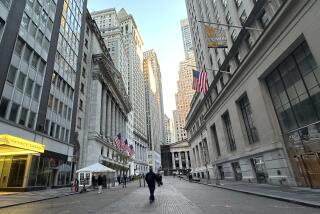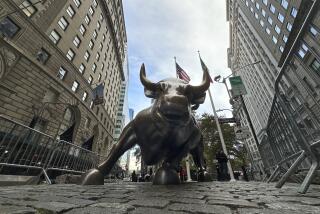In Period, Many Found Shelter in Blue Chips
- Share via
Wall Street ended the third quarter Friday by falling just short of an all-time high for the Dow Jones industrial average -- a near miss that may reflect investors’ uncertainty about the next move for the economy and stock prices.
The blue-chip index rose as high as 11,741.99 in early trading, surpassing its previous closing peak of 11,722.98 on Jan. 14, 2000. The mood ebbed as the session wore on, however, and the Dow finished at 11,679.07, down 39.38 points, or 0.3%.
Although big-name share indexes surged in the third quarter, that was in part out of fear, analysts said. After a sharp pullback in markets worldwide in June, and as worries about the U.S. economy increased, many investors turned to familiar, blue-chip stocks as a haven.
Some of the things that investors cheered in the third quarter -- including the Federal Reserve’s decision to pause in its credit-tightening campaign and tumbling energy prices -- also could be warning signs that the economy is decelerating quickly, said Kevin Caron, investment strategist at brokerage Ryan, Beck & Co. in Florham Park, N.J.
That, in turn, could threaten the stellar corporate earnings growth that has buttressed the stock market since 2002, Caron said.
He puts the chance of a recession in 2007 at about 50%. “I think the market’s going to have a tough time moving ahead” if concern about the economy deepens, he said.
Many market pros, however, still are betting on a soft landing for the economy: growth that’s slow enough to keep the Fed on hold but strong enough to keep earnings advancing.
“I think the economy is going to come into a soft landing, then re-accelerate” later in 2007, said Tony Dwyer, equity strategist at FTN Financial in New York.
For the three months ended Friday, the Dow rose 4.7%, its biggest gain since the fourth quarter of 2004. The broader Standard & Poor’s 500 index of large-company shares jumped 5.2%.
By contrast, small-company stocks -- the market’s stars of the last six years -- took a back seat to blue chips as investors turned more cautious about the economy.
The Russell 2,000 index of smaller shares, which rose 7.6% in the first half, bounced back from its lows of late July but eked out only a 0.1% gain for the third quarter.
“Small stocks have been unable to regain their leadership,” said John Bollinger, head of Bollinger Capital Management in Manhattan Beach.
Many foreign stock markets, favorites of U.S. investors over the last two years as they hunted far and wide for higher returns, also failed to recoup all of their losses from the mid-May to mid-June slump.
Brazil’s main stock index slipped 0.5% in the quarter and at Friday’s close was 13.2% below its record high reached May 9. The Canadian market is nearly 6% below its spring peak.
But the Mexican market hit a record this week, and the German and French markets are just below their spring highs.
The average foreign-stock mutual fund rose 3.6% in the quarter, better than the 2.3% advance of the average U.S. stock fund, according to preliminary data from Lipper Inc.
Dwyer of FTN Financial thinks the stock market may take a timeout in October -- which has a reputation as a volatile month.
“It’s a tired market. It’s had a nice run,” Dwyer said. But he expects the rally to resume in November and December.
Bollinger said that because so many investors are looking for trouble in October, the surprise could be that the market keeps rising instead.
One big question is what third-quarter earnings will say about the economy as companies begin reporting in a couple of weeks.
Despite expectations for slower profit growth, Standard & Poor’s projects that S&P; 500 operating earnings will again rise at a double-digit rate. S&P; says profits should rise about 14% year over year, which would be the 18th consecutive quarter of double-digit gains.
Among Friday’s market highlights:
* The S&P; 500 index slipped 3.30 points, or 0.2%, to 1,335.85. The Nasdaq composite lost 11.59 points, or 0.5%, to 2,258.43 but was up 4% in the quarter.
* In the bond market, the 10-year Treasury note yield finished at 4.63%, up from 4.61% on Thursday but down from 5.14% at the end of the second quarter.
Bond yields fell in the period as the Fed held its key short-term rate at 5.25% and economic data pointed to slower growth, relieving inflation worries.
* Near-term crude oil futures in New York closed at $62.91 a barrel, up 15 cents. Oil plunged from a peak of $77.03 in mid-July, leading a broad decline in commodity prices as traders bet on weaker demand.
* Shares of major home builders declined on renewed fears about a hard landing for the housing market. KB Home lost $1.34 to $43.80 and Pulte Homes fell 99 cents to $31.86. Still, many stocks in the sector managed to inch up in the quarter after diving in the first half in anticipation of falling demand.
* Gold closed at $598.60 an ounce in New York futures trading, down $6.40 for the day. The metal eased 2.4% in the quarter.
*
Begin text of infobox
Index trends
The performance of stock indexes in the third quarter and year to date:
Dow industries:
Quarter -- +4.7%
Year to date -- +9.0%
*
S&P; 500:
Quarter -- +5.2%
Year to date -- + 7.0%
*
Russell 2,000 (small stocks)
Quarter -- +0.1%
Year to date -- +7.8%
*
S&P; 400 (mid-size stocks)
Quarter -- -1.4%
Year to date -- +2.2%
*
Nasdaq composite
Quarter -- +4.0%
Year to date -- +2.4%
*
Source: Bloomberg News
More to Read
Inside the business of entertainment
The Wide Shot brings you news, analysis and insights on everything from streaming wars to production — and what it all means for the future.
You may occasionally receive promotional content from the Los Angeles Times.










